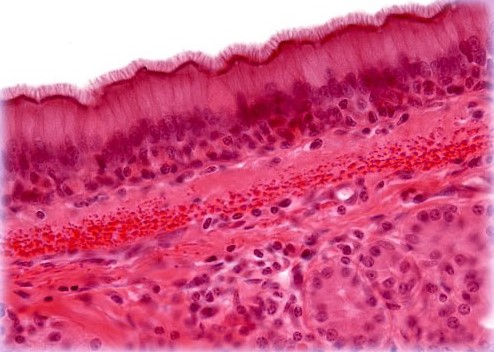Pseudostratified Columnar Epithelium Definition
Pseudostratified columnar epithelia are single-layered tissues that appear to have multiple layers, especially in cross section. These epithelial cells have nuclei at different levels, giving the appearance of stratification. Despite the fact that this tissue consists of a single layer of cells, each cell is in contact with the basement membrane, even though the cells do not share an apical surface.
Due to the rarity of pseudostratified epithelia made from cuboidal or squamous cells, pseudostratified columnar epithelia are the most common subtype.
Types of Pseudostratified Columnar Epithelia
Based on a cellular organelle involved with motility and sensory activity, these tissues can be classified as ciliated or non-ciliated.
The primary cilium of every eukaryotic cell plays a crucial role in developmental signaling pathways and tissue homeostasis. Most cells do not contain motile cilia, despite the presence of a primary cilium.
These microtubule-based structures move particles in a coordinated manner by beating in a coordinated manner. An ovum propelled down the fallopian tube towards the uterus could be one of these particles, such as dust and pathogens in the respiratory system.
Stereocilia are cytoplasmic projections of these epithelia even if they are not ciliated. The actin microfilaments used in these structures are stiffer than those used in motile cilia. In the male reproductive tract, they have an absorption or mechanosensory function.
Functions of Pseudostratified Columnar Epithelia
Mucus is secreted by this tissue when foreign bodies need to be trapped and swept away via cilia movement. As well as in the vas deferens and epididymis, they can also be found where the epithelia have both absorptive and secretory functions. A stereocilium is a cytoplasmic projection made of actin microfibrils found in such tissues.
Examples of Pseudostratified Columnar Epithelia
Several of these tissues contain goblet-shaped mucus-secreting cells and longer columnar cells that cover the entire epithelium. Their apical surfaces do not reach the lumen, and they also contain short basal cells. A basal cell can become either a goblet cell or a columnar cell.
Upper Respiratory Tract Epithelium
Air is brought into close contact with blood flowing in capillaries in the respiratory passage in order to exchange gases at the alveoli. In order to maximize gas diffusion, capillaries and alveoli are made of thin squamous epithelial cells. Large dust particles, pollutants, pollen, and corrosive agents and pathogens can abrade these delicate surfaces.
Lungs are protected from these irritants by pseudostratified columnar epithelium in the upper respiratory tract (composed of the nose, trachea, and bronchi). The goblet cells of the epithelium secrete mucus to trap particles and prevent them from traveling further down the respiratory tract.
Mucus and particulate matter are moved away from the lungs by cilia on longer columnar cells facing the lumen. Sneezing or coughing removes larger or heavier particulate loads while normal nasal drainage removes smaller particles.
Vas Deferens and Epididymis
The vas deferens and epididymis of male reproductive tracts have pseudostratified columnar epithelium. These organs contain stereocilia, which are similar to microvilli in the digestive tract.
A large amount of fluid must be used to propel sperm from the testes to the epididymis because they are non-motile. During ejaculation, stereocilia absorb excess fluid from the epithelial cells lining the tubular structure and allow sperm to be concentrated.
Related Biology Terms
- In many epithelial tissues, basal cells are small, round cells covering the basement membrane, which often serve as precursors to more differentiated and mature cells.
- Sperm maturation occurs in the epididymis, which connects the testis to the vas deferens.
- The lumen is the inner space within a tubular structure or the inner surface of a hollow organ or organelle.
- Vas deferens – The long, muscular tubes that carry sperm to the ejaculatory ducts from the epididymis.

